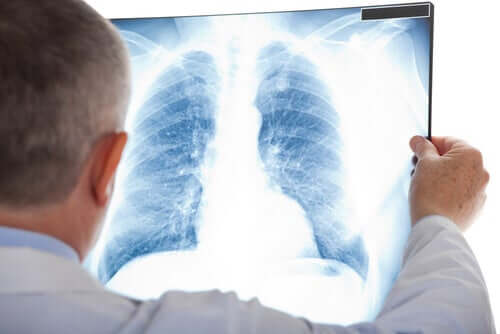Pleurisy: Symptoms, Causes, and Treatment


Written and verified by the doctor Leonardo Biolatto
Pleurisy also is called pleuritis. Both terms refer to the same situation: inflammation of the lining known as the pleura.
The pleura is a thin lining that surrounds the lungs and separates them from the chest wall. Actually, the pleura has two layers; one of them adheres to the lung and the other to the chest wall.
There’s a tiny space between the two layers. This space is known as potential because it doesn’t exist nor is it evident, unless something occupies it. Air can occupy that space, constituting a pneumothorax. Also, a liquid substance can occupy it as well, constituting a pleural effusion.
It’s common for pleurisy to be associated with pleural effusion. When the pleura is inflamed, it can produce inflammatory fluid that deposits in the pleural space. This indicates that different pleura disorders may respond to the same cause.
The causes of pleurisy
Pleurisy has different causes. These are some of the disorders that can cause inflammation of the pleura:
- Autoimmune diseases. Some autoimmune diseases attack the pleura. For example, rheumatoid arthritis, which is a cause of pleurisy.
- Lung cancer. This oncological disease may attack the pleura. Sometimes, the pleural membranes swell due to proximity to the primary tumor. Other times, because lung cancer metastases lodge in the pleura.
- Pneumonia. When you suffer bacterial or viral pneumonia, the pleura inflames due to the infectious process.
- Mycosis. Some fungi that infect humans, precisely in their internal organs, can lodge in the pleura. Fungal pleurisy is difficult to treat because antifungals need a lot of time to start acting and because the drugs don’t access the pleura as fast as other organs.
- Thorax trauma. Trauma to the chest and side of the chest wall, more precisely in the ribs, is associated with pleurisy. Inflammation happens due to cohesion and closeness to neighboring structures.

Keep reading: Scientists Discover Nanoparticles from Tea Leaves that Kill Lung Cancer Cells
Symptoms of pleurisy
The characteristic symptom of pleurisy is chest pain. Overall, it’s an intense but intermittent pain, which exacerbates when the patient coughs or takes deep breaths.
Dyspnea manifests along with the pain. Dyspnea is a perceived lack of air, either during inhalation or exhalation. As in a vicious cycle, breathing overexertion can worsen the chest pain. Other symptoms will depend on the cause of pleurisy.
- If it’s pneumonia, the patient will also suffer from fever and coughing.
- If it’s lung cancer, the patient will have weight loss, anemia, or changes in skin color.
- When an autoimmune disease happens, it often affects the joints, for example.
If pleurisy is accompanied by pleural effusion, the characteristic pain will vary slightly. The accumulated liquid worsens the pain in certain bodily postures and positions. Dyspnea is also more evident due to the pressure of the effusion on the lung.

Keep discovering in this article: The Causes of Chest Pain When Coughing
Treatment
The treatment greatly depends on the cause. Remember that it isn’t a disease in and of itself, but rather a situation that arises from another pathology.
A patient can manage the pleurisy pain with anti-inflammatory drugs, regardless of the original cause. Medical professionals commonly recommend ibuprofen for pain management. In more severe cases, the patient can resort to morphine and its derivatives.
When the patient’s pain worsens when they cough, the doctor may evaluate the use of antitussives. However, they aren’t always recommended because coughing is a defense mechanism the body uses to solve an atypical situation.
For infections, an antimicrobial treatment can fight the invading agent. There are protocols for pneumonia, fungal infection, and flu-like clinical situations that determine what steps to take at each stage.
If pleural effusion is associated with pleurisy, the doctor will assess the need for drainage. In this regard, they can extract the liquid contained in the pleura with certain procedures. Not all effusions need to be drained.
If a patient has pleurisy, their medical professional needs to find the cause. As such, they’ll seek the complementary methods they deem appropriate to reach a diagnosis. Once they discover the cause, they can indicate a treatment to address the underlying situation.
All cited sources were thoroughly reviewed by our team to ensure their quality, reliability, currency, and validity. The bibliography of this article was considered reliable and of academic or scientific accuracy.
- Porcel, José M. “Advances in the diagnosis of tuberculous pleuritis.” Annals of translational medicine 4.15 (2016).
- Porfyridis, Ilias, et al. “Outcome of patients with non specific pleuritis after medical thoracoscopy.” (2016): PA3392.
- Lafitte, Juan Pablo. “Tratamiento de la pleuresía con derrame.” (2015).
- Crisafulli E, Aredano I, Valzano I, Burgazzi B, Andrani F, Chetta A. Pleuritis with pleural effusion due to a Bacillus megaterium infection. Respirol Case Rep. 2018;7(1):e00381. Published 2018 Nov 28. doi:10.1002/rcr2.381
- Sharma JK, Marrie TJ. Explosive pleuritis. Can J Infect Dis. 2001;12(2):104–107. doi:10.1155/2001/656097
This text is provided for informational purposes only and does not replace consultation with a professional. If in doubt, consult your specialist.








